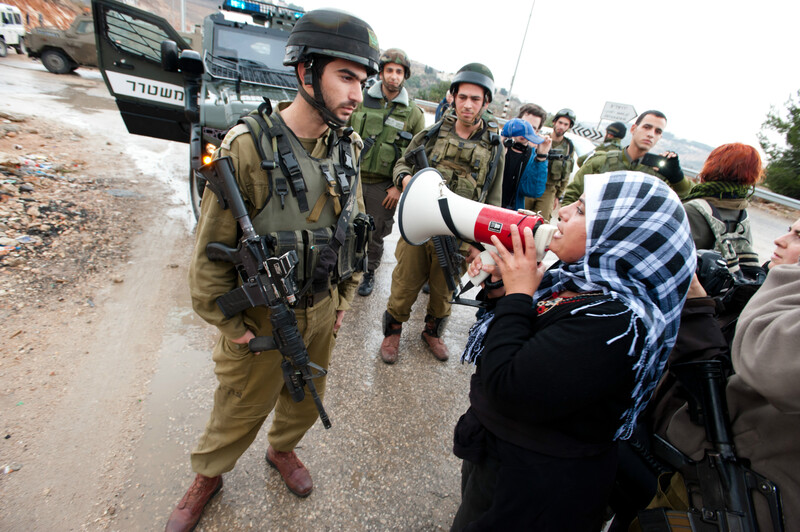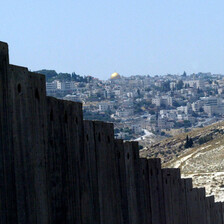The Electronic Intifada al-Walaja 18 April 2012

Al-Walaja resident and activist Sheerin al-Araj is fighting to protect her village.
Sheerin al-Araj, resident of the village of al-Walaja and an activist with the Popular Committee Against the Wall, is a woman of courage, intellect and dry humor. Her knowledge of the area is unsurpassed, enriched by years of experience, living through the relentless temerity of the occupation.
Firm roots
We sit under a cherry tree, the web of shadows protecting us from the intense heat. Al-Araj’s roots are embedded firmly in this village. After 1948, her family was forced to flee. She points to a cave a stone’s throw away from the cherry tree. “This is where we lived for 12 years,” al-Araj says. “We never left the area because we always thought we were coming back.”
After the tumult of Israel’s inception, internally displaced refugees were given cards based on their geographic location. Intending to receive a blue one for Jerusalem residents (her municipality at the time), she received an orange one (solely limiting her to the West Bank, and prohibiting her from traveling across the Green Line), with half of her village apportioned for the settlements of Gilo and Har Gilo. She became a living oxymoron, a “present absentee,” physically there but legally absent. We all laugh at the absurdity; an absurdity that has come to characterize Israel’s policy toward Palestinians.
Trapped
Her house is trapped in between a settlement on one side, an Israeli-only road on another. A tunnel to connect the two runs under her house. She jokes that she will build her house upwards just to infuriate the authorities.
She takes us to the wall and explains how its design admonishes the consciousness of the settlers. On the Palestinian side are the concrete eyesores, but, adjacent to them — on the side of the Har Gilo settlement — a beautifully crafted wall has been built which blocks the view of Israel’s wall. She once asked the soldiers why they did this and they replied “we wanted to give you the opportunity to be creative.”
She has contested the confiscation of the village’s land but the courts inevitably rejected her: Israel’s high court ruled against the people of al-Walaja in August last year. Her realism is insightful: “we know we won’t win, but it buys us time.”
She points to a monastery that is owned by the Catholic Church. Remarkably, the church did not help with the court action. She explains that the monastery, which makes wine, preferred the wall to be carved into the occupied West Bank because many Palestinians do not drink alcohol — the power of profit subjugating the people. To add insult to injury, the Catholic Church uprooted 1,800 pine trees to build a road directly to Jerusalem.
Gaping hole
We walk towards a gaping hole in the wall where it has yet to be finished. The surrealism and confusion washes over us all. I try to figure out how security can be the pretext for this wall’s construction as I can still see West Jerusalem from its neighboring Palestinian village.
Trucks and bulldozers carrying large rocks drive past us with one of the workers waving at me. We all grit our teeth. Al-Araj highlights the fragility of this pretext. “If I’m so scared of my neighbor, I’ll build a wall around him because that won’t anger him,” she says sarcastically. Much of the discourse about security, often laced with racist sentiment towards the residents of al-Walaja, quickly evaporates.
The surrealism ensues.
We move further into the forbidden. The picture that greets us resembles a jigsaw where the pieces don’t quite fit: new terracotta-roofed houses that look transplanted from the near distance of the settlements’ tableau-vivant.
Tearing a cemetery apart
Al-Araj tells us a story of a Muslim-Christian couple who live on the “wrong side” of the wall. They built a private cemetery so that they could buried next to one another, a testament to their love. But the wall’s intended path threatens to tear the cemetery in two. It is almost as if the wall has a mind of its own, choosing a path which is intended to cause maximum destruction.
The residents here face an uncertain future. They are nonetheless decisive. Al-Araj grabs a young boy whom she knows very well and points to him, saying, “this is the terrorist they are apparently trying to stop.” The boy, full of cockiness and excitement, runs off with a smile.
Al-Araj takes us further into the so-called buffer zone, her stories intermittently drowned out by the passing trucks. We edge in towards a house that will be barricaded in by electrical fencing. The intended route of the wall means that a tunnel will be needed to circumvent its snake path. Al-Araj explains that the route of the wall underscores how it is a blueprint for annexation.
I walk on, trying to make sense of the surroundings. On the first horizon, I see annexed land onto which Israel has pushed more of its residents. On the second horizon, I see West Jerusalem. I hear the crunch of the hard grass behind me and see my friend who has lived in Abu Dis, East Jerusalem all his life.
He looks longingly into the area where he can never walk. He stays silent but then utters a few humble words: “it’s not fair.”
There is a nuance in the nature of the occupation. It is not just overt aggression, it is something more sinister. It is bullying, picking on the weak, shoving it in their face. Just a few minutes in al-Walaja with Sheerin al-Araj illustrates how the occupation is the absolute salt in the wound.
Tanzil Chowdhury is a researcher studying at the University of Manchester. His research interests include Israel/Palestine, law and human rights. He is currently volunteering in Abu Dis, East Jerusalem, with Camden-Abu Dis Friendship Association (CADFA), working in schools, universities and the Dar Assadaqa Community Center.


